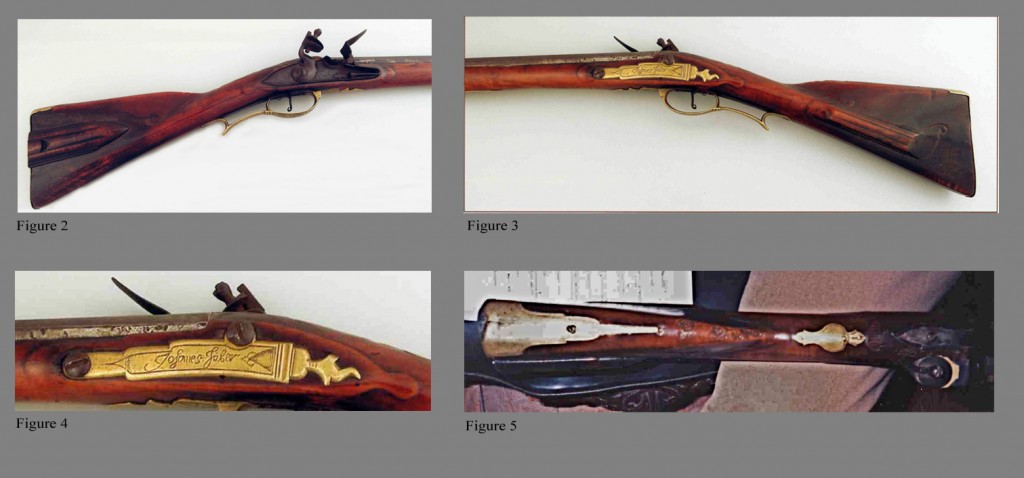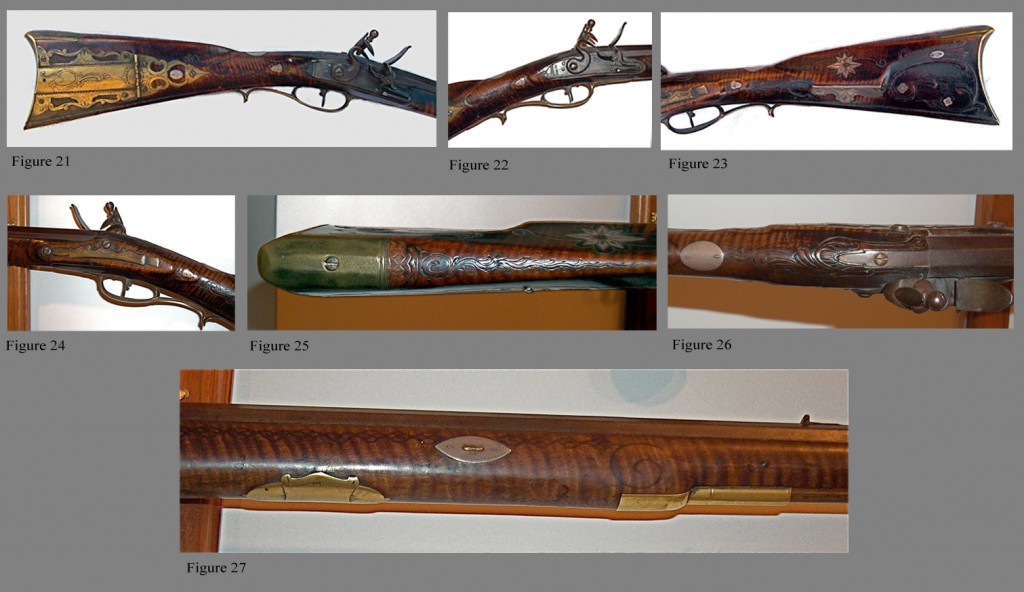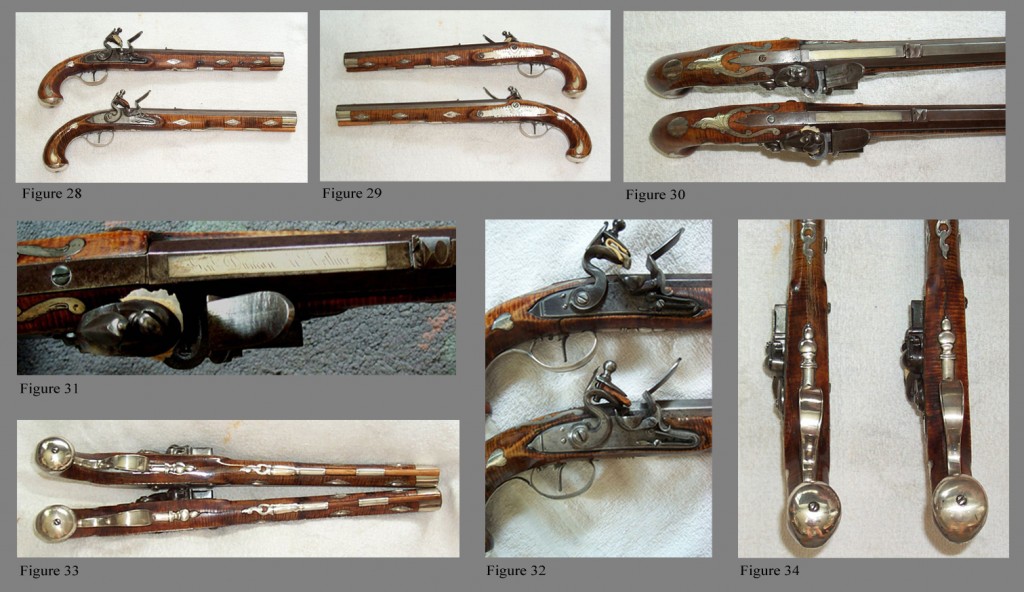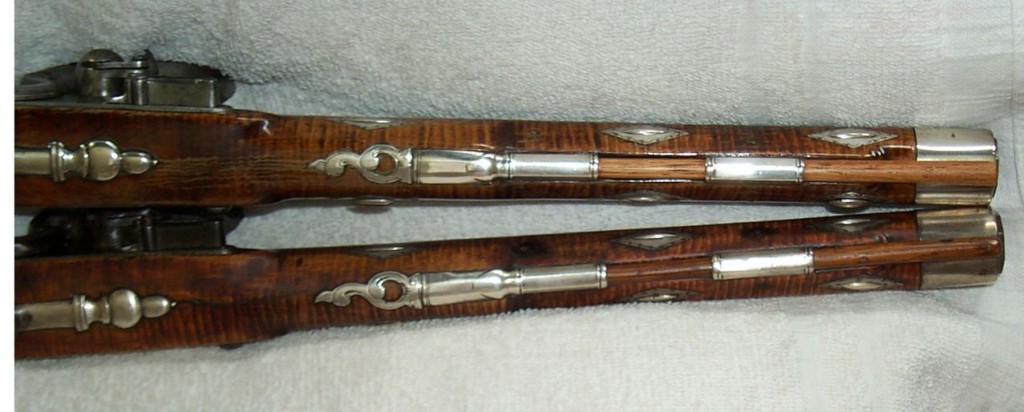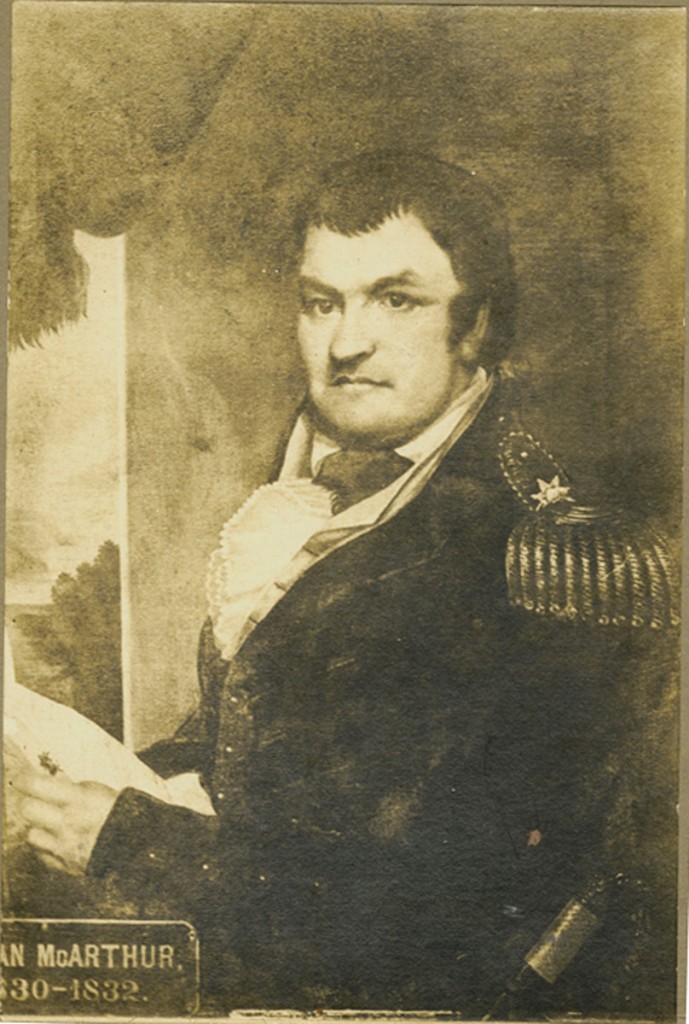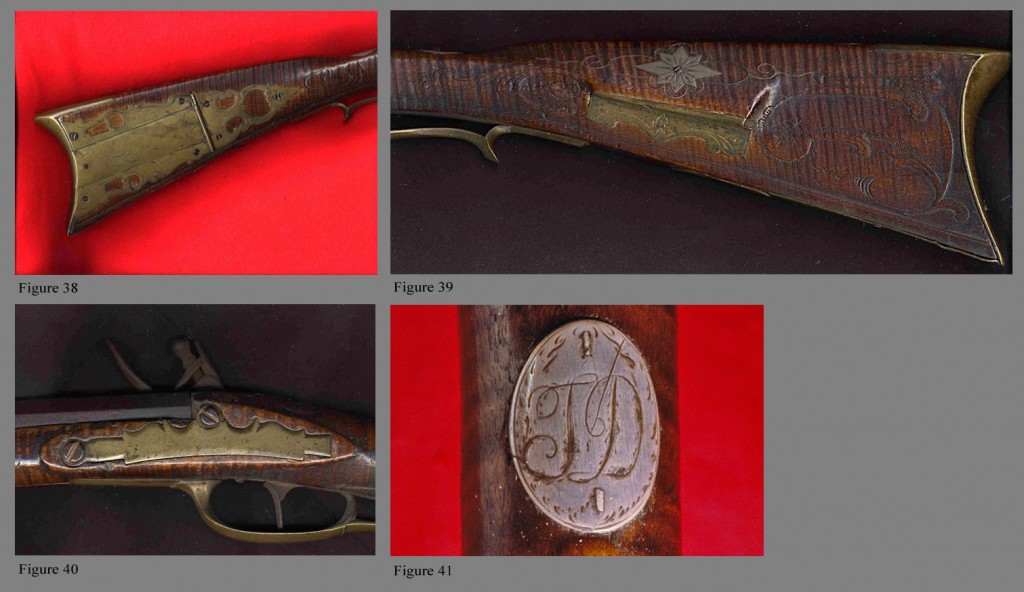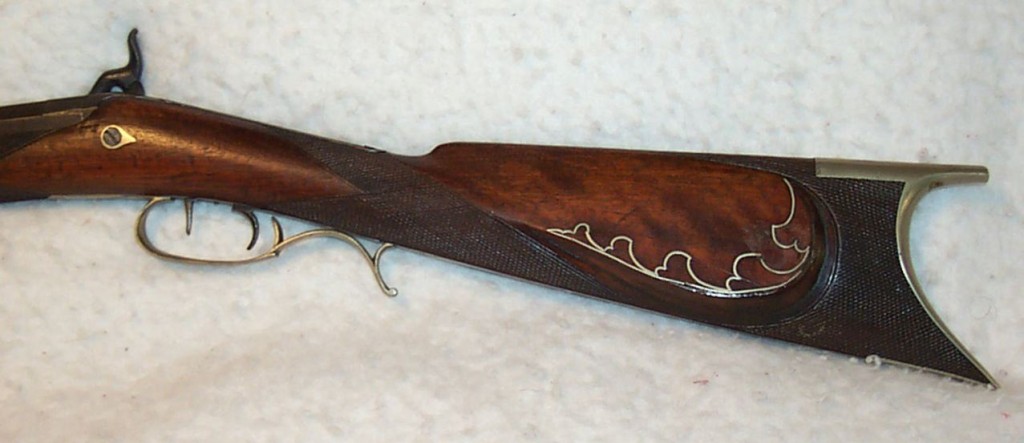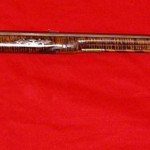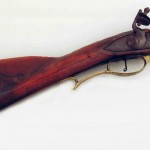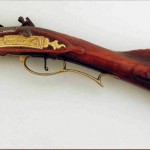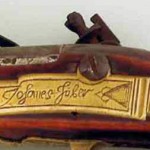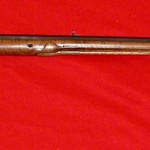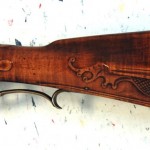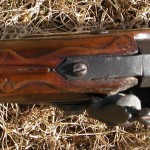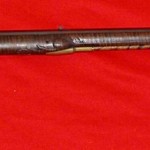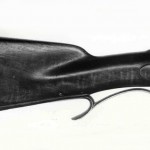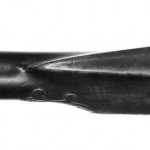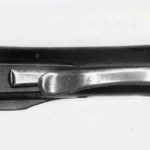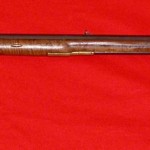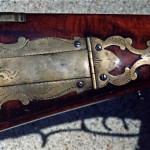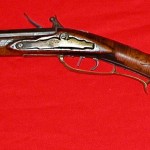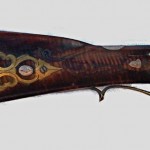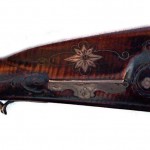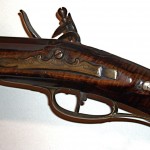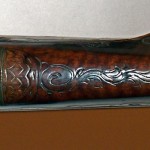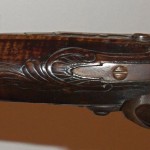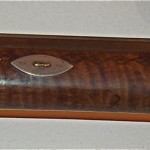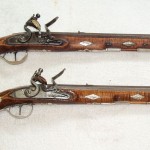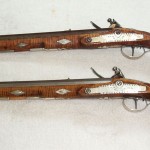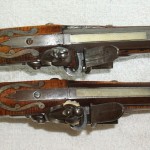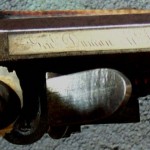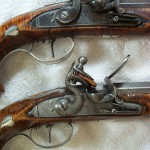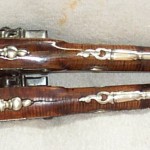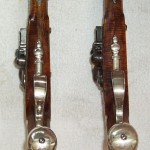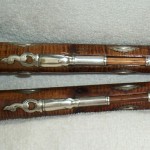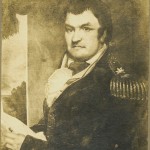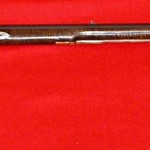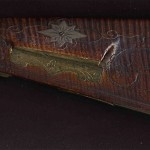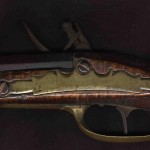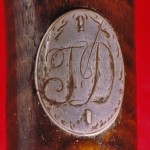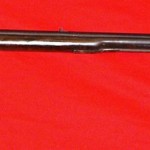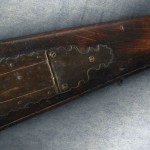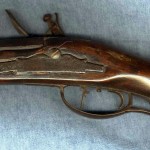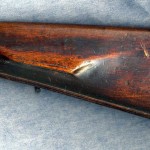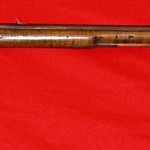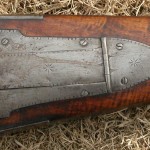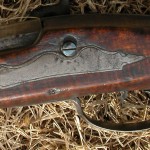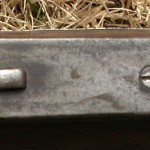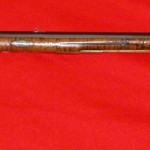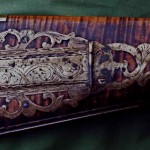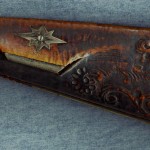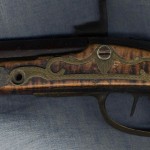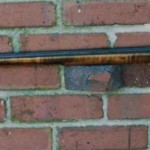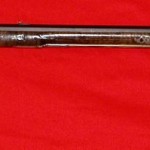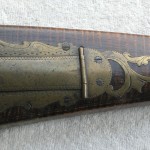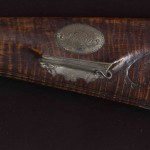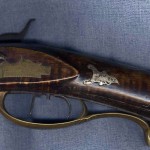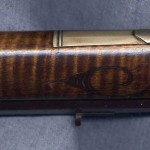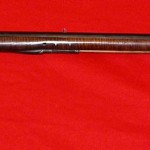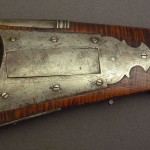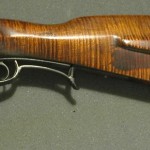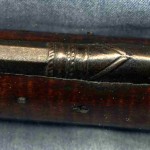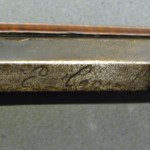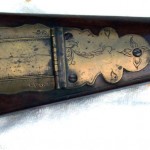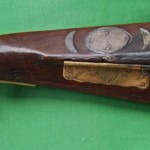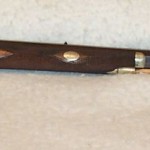Is it a utilitarian tool or artwork?
By Jim Melchor and Tom Newbern
Editor’s Note: Higher resolution photographs are available at the end of this articleFirst, let us discuss the name, Kentucky rifle. This term is not found in eighteenth and early nineteenth century wills and inventories. Instead, the American longrifle was generally listed simply as “rifle gun” in those documents. The term, Kentucky rifle, was coined in a song shortly after the Battle of New Orleans during the War of 1812. The song credited much of Gen. Andrew Jackson’s American victory over the British to his Kentucky riflemen and their Kentucky rifles. Ever since, Kentucky rifle has become the generic term for all longrifles, not just those made in Kentucky. In fact, German emigrants in eastern Pennsylvania developed the longrifle in the second quarter of the eighteenth century from the German jaeger, a short, hunting firearm with a rifled barrel. Gunsmiths, primarily in Pennsylvania, Virginia, Maryland, North Carolina, Kentucky, Tennessee, and Ohio produced longrifles or Kentucky rifles in large quantities.
Kentucky rifles are single-shot, black-powder, muzzle-loaded, long, graceful firearms (Fig. 1). They consist of a full-length stock, generally of curly maple or walnut. Longrifles have barrels around 44” long with calibers ranging from around .28 caliber to around .60 caliber. They fire a round ball partially wrapped in a cloth patch that is moistened with grease or spit. The purpose of the patch is to engage the rifling in the barrel thus spinning the ball when shot. The patch falls free of the ball when the ball exits the muzzle. This spinning stabilizes the ball in flight, increasing its accuracy and range. The black-powder charge is ignited by a lock mechanism when the trigger is pulled. Up through the first quarter of the nineteenth century, longrifle locks were flintlocks. A flint in the cock or hammer of the lock strikes the steel frizzen, thus producing sparks that ignite a small powder charge in the pan that in turn ignites the main powder charge in the barrel. Later longrifles were equipped with percussion locks that use a disposable percussion cap with a small explosive charge to ignite the powder in the barrel. Many, if not most, early Kentucky rifles were converted to the more modern percussion locks to extend the service life of the rifles.
Longrifles were the quintessential firearms of the American frontier from roughly the 1750s to the 1840s. There is no mistaking a Kentucky rifle, and it is purely an American form. For the most part, individual gunsmiths built these longrifles one at a time – “lock, stock, and barrel”.
The Kentucky rifle was not developed as a military weapon per se. Rather, it was developed as a personal firearm for protection, sustenance hunting, target shooting, and display. However, it served very well as a military firearm brought by citizen solders during the French and Indian Wars, the Revolutionary War, the War of 1812, numerous other smaller conflicts, and even the Civil War.
Now let us answer the questions posed in the title. The answer is yes to both. By far, most longrifles were unadorned utilitarian tools with no decorative brass or silver fittings (such as patch boxes, side plates, wear plates, etc.), engraving, carving, inlays, or other artwork. In fact, most were mounted with simple iron furniture (ie. metalwork). Nevertheless, they were still graceful and aesthetically pleasing in form. For a few extra pence, pounds, or dollars from the purchaser, however, the gunsmith would upgrade the rifle to brass or even silver furniture and add embellishments, not unlike car manufacturers do today. Similar to American architecture in the Colonial and Federal periods where the grand homes have survived in greater quantities than the simpler more plentiful lesser homes, the better longrifles, too, have had a better survival rate. With both architecture and longrifles, the skewed survival of better examples can lead one today to the erroneous belief that what has survived reflects what was produced originally. This, indeed, is not the case. In fact, the vast majority of lesser examples of homes as well as longrifles have been lost through attrition.
Similar to other disciplines such as architecture, music, decorative arts, etc., Kentucky rifle-making can be roughly grouped into three, basic, recognized, art-history periods – baroque, rococo, and neoclassical. Each period of longrifles had its basic models and a progression of enhanced models. For this article, we will focus only on a few Virginia-made Kentucky rifles, mainly the enhanced varieties. However, similar examples exist from the other regions as well.
Some longrifles are signed by the maker. Fewer still have an owner’s name or initials. This information, when present, is most helpful in the study of Kentucky rifles. Unfortunately, most longrifles do not have written signatures. Not all is lost, though. Architecture, decorations, and construction characteristics often serve as unwritten signatures, thus allowing the scholar to identify a maker or a region in which the rifle was made.
Arguably, the earliest known Virginia longrifle was probably made by Johanes Faber circa 1750 in Rockbridge County, VA (now Augusta County) (Figs. 2 & 3). While signed “Johanes Faber” on the side plate (Fig. 4), there is no definitive documentary proof that Faber was a gunsmith. Faber is a common name in the area, and he might have been the first owner. This longrifle descended in the Davis family of Augusta County.1 Regardless of who actually made it, this wonderful, early, Virginia rifle most likely saw service in the French and Indian Wars, the Revolutionary War, possibly the War of 1812, and, by family tradition, the Civil War.2
The heavy, musket-like architecture (ie. shape) of the butt stock and decoration on the Faber rifle are early, and the rifle retains its original flintlock. As seen in Fig. 2, the butt stock is fitted with a patch box with a sliding wooden lid, an enhanced feature found on early longrifles. A more basic rifle would not have had a patch box. The minimal carving behind the cheek piece as seen in Fig. 3 and the decorative, brass side plate with engraving also are both enhancements to this rifle. The engraved brass trigger guard, shaped brass thumb piece (Fig. 5), and brass butt plate with the long heel extension are enhancements as well. Also note the beavertail carving around the side plate and lock in Figs. 2 & 3 and the carving around the tang in Fig. 5. These enhancements along with the architecture of the rifle reflect the conservative baroque taste of the time. For more detail photographs and information on this longrifle, see Shumway3. A basic, unadorned rifle would likely have had an iron trigger guard and possibly no butt plate. While a base model would have had a cheek piece, it certainly would not have had any carving or engraving. Both being utilitarian tools, the enhanced rifle and a base-model rifle would have functioned the same. First and foremost, they were shooters.
The longrifle seen in Fig. 6 dates circa 1765-70 and probably was made in western Rockbridge County, VA (now Augusta County)4. It remains in its original flintlock condition. This rifle is unsigned, and its maker is not known; however, it relates to several other rifles from this area. The initials, “RMC”, are engraved on the lid of the patch box so orientated as to be read by someone holding the rifle. These initials are probably those of the owner, but Ivey would argue otherwise5.
Here, we see an early rifle in a clear transition from the baroque to the rococo. While it retains the thick, heavy butt stock, its architecture has moved away from the musket-type architecture seen in Fig. 2. Note here the development of the slightly curved butt plate. This butt-plate curvature became even more pronounced as the Kentucky rifle progressed through time. This graceful longrifle is obviously an enhanced version with carving and brass furniture. The brass patch box (Fig. 7) has a free-form daisy finial in the rococo taste. Also, in this figure, note the beavertail carving around the lock, as seen on the Faber rifle in Fig. 2, as well as the molding cut along the butt stock from the trigger guard to the butt plate. On the left side of the butt stock, under and behind the cheek piece (Fig. 8), there is considerable, free-form, relief carving. While very well executed in high relief, this carving is more naive rococo, even folk art, in nature rather than academic. In Fig. 8, also note the decorative brass side plate and the beavertail, relief-carved molding around it. The symmetrical, relief carving around the tang (Fig. 9) harkens back to the baroque taste. Note the small heart in this carving. Decorative heart devices come from the German fraktur tradition.
The signed, Frederick Klette rifle of circa 1775-80 (Fig. 10) is likely the singularly most published Kentucky rifle. Klette was the master armorer at the Rappahannock Forge in Falmouth, VA during the Revolutionary War, and his home was the crossroads of Stevensburg in Culpeper County, VA outside of Fredericksburg, VA6. The German-style lock on this rifle is signed “F Klette”, and the barrel is marked “S(t)evensburg”. The “t” was missed during engraving.
Even though the Klette rifle postdates the Faber and the longrifle in Fig. 6, it is nearly pure baroque in taste. A symmetrical, decoratively shaped, highly engraved patch box in the baroque taste is installed on the heavy, musket-like butt stock (Fig. 11). In this photograph, note the signed lock plate, the heart engraved on the lock plate reminiscent of the heart in the tang carving on the rifle in Fig. 9, and the similar beavertail carving around the lock plate as seen on the previous two rifles (see Figs. 2 & 7). The baroque relief carving on the left side of the butt stock of the Klette rifle (Fig. 12) is well executed and is more academic in nature than the carving seen on the early rifle in Fig. 6 (see Fig. 8). In Fig. 12, note the distinctive, nicely engraved, brass side plate with the carved, beavertail molding. Additional carved and engraved baroque features on the Klette are the carving around the tang, the engraving on the tang, and the engraving on the heel of the brass butt plate (Fig. 13). Figs. 14 & 15 illustrate the decorated brass trigger guard and the terminal ramrod pipe with the same decoration and with relief carving on the stock flowing from the pipe.
Obviously, the Klette rifle was a high-end firearm at the time with all the “bells and whistles”. Apparently, Frederick Klette made this longrifle for himself, as there are no other known rifles or other firearms for that matter by him.
Following the close of the Revolutionary War, the Kentucky rifle flourished as an art form. Patrons with discerning tastes and finances to match paid gunsmiths to embellish their rifles to a degree not previously seen. This movement reached its peak in the 1790s and has become known as the “Golden Age”. This is not to say that base-model rifles and rifles enhanced to a lesser extent than the “Golden Age” examples were not produced as well. In fact, as previously noted, the vast majority of Kentucky rifles built were base models and rifles with minimal enhancements.
Fig. 16 is an example of a Kentucky rifle leading into the “Golden Age”. John Haymaker, working in the Simon Lauck shop in Winchester, VA, made this longrifle circa 1785-90. Even though this rifle is not signed by the maker, it is very closely related in architecture, carving, and inlay to two other signed Haymaker rifles7. While the patch box (Figs. 17 & 18) still reflects the earlier baroque taste, the incised and relief carving on this longrifle (Fig. 19 & see Fig. 17) is full-blown, rococo. There is no question that John Haymaker understood academic carving and could execute it. He developed the opposing-C-scroll, carving design for the butt stock (see Fig. 19) that has become synonymous with the Lauck shop and is reflected in the work of those gunsmiths that trained there. Further, he developed the shock-wave carving design on the wrist (see Fig. 17) and emitting from the upper scroll of the C-scroll carving on the butt stock (see Fig. 19). This design, too, is associated with the Lauck shop. Also note in Fig. 19 the silver-star inlay, the brass furniture, and the curved butt plate. The butt stock, while still substantial in thickness, is purely Kentucky rifle in architecture and is no longer musket-like. This rifle is a pre-“Golden Age” example, not a fully developed “Golden Age” Kentucky. Nevertheless, it is a well-appointed longrifle ranking at the top of its class, far above a base model.
The iron knob or projection below the butt stock is a flash-hole pick (see Fig. 17). A flash-hole pick was used to clean the small opening or flash hole in the barrel that allowed the sparks and fire produced by the flintlock to enter the barrel to ignite the powder charge.
A true, Virginia-made, “Golden Age” Kentucky rifle from the 1790s is the signed Frederick Sheetz rifle. Frederick Sheetz trained in the Lauck shop in Winchester, VA before moving to Hampshire County, VA (now WV). This flintlock longrifle is in the full, free-flowing, rococo taste, and its curly-maple stock is mounted with brass furniture, brass and silver inlays, and silver wire inlays. If “a picture is worth a 1000 words”, here are 8000 words worth of pictures to show just how good a Kentucky rifle can get (Figs. 20-27). All the functional and decorative features of these high-end rifles were integrated to flow into the whole. These rifles were well designed, not slapped together like notes on a corkboard. In Fig. 23, note the opposing C-scrolls in the carving behind the cheek piece, a design element carried over from the Lauck shop. Note also the engraved silver inlays as well as the silver wirework around the star. The silver device below the cheek piece is a holder for the flash-hole pick. Fig. 25 shows the free-form incised carving on the top or comb of the butt stock. Both incised carving and relief carving were used to decorate this rifle. In Fig. 26, note the wonderful, asymmetrical, rococo carving around the tang. Also in this photograph, there is an unwritten signature or feature that Frederick Sheetz used in his work. All of his inlays are affixed with rectangular rather than round pins. This construction technique is helpful to scholars in identifying unsigned rifles by him8. Fig. 27 shows incised carving on the stock, a silver escutcheon for the brass drawdown pin that holds the barrel in the stock, and a brass wear plate. Brass wear plates, installed at the balance point on a rifle to help reduce stock wear from extended carrying, are uncommon and were an added expense. Again, note the rectangular pins attaching the escutcheon and the wear plate.
This privately owned rifle ranks in the top three or four Virginia-made, “Golden Age” Kentucky rifles. It is in good company with the John Sheetz rifle9 at Colonial Williamsburg and the Simon Lauck rifle at Winterthur. These are the finest expressions of American mechanical art, and they are true American treasures!
While this article is about Kentucky rifles, one pair of Kentucky pistols, on par with the “Golden Age” Kentucky rifles, must be included. These are the Gen. Duncan McArthur pistols. These pistols are silver mounted, double barrel, over/under, and most likely out of the Lauck shop in Winchester, VA early in the nineteenth century.
As with the above presentation of the Frederick Sheetz rifle, the McArthur pistols are best presented in photographs (Figs. 28-35). Another 8000 words worth of pictures should tell the story.
General Duncan McArthur (Fig. 3610) and President William Henry Harrison were close personal friends. According to McArthur-family tradition11, Harrison owned the pistols and gave them to his friend, Gen. Duncan McArthur, when McArthur relieved Harrison as commander of the Army of the Northwest, Ohio Territory. Duncan McArthur later served in the US House of Reps. from Ohio and then as Governor of Ohio. He died in 1839.
The pistols were separated c. 1830 when Duncan McArthur gave one each to two grandsons, William Henry Harrison McArthur and Smith McArthur. The pistols subsequently descended in two separate branches of the McArthur family. The tradition in both branches of the family was that the other pistol was destroyed in a fire. Obviously neither was. Through extensive research and even more luck, the two pistols were reunited in 2002. They are now on loan to Colonial Williamsburg and displayed in the Art Museums of Colonial Williamsburg along with the John Sheetz “Golden Age” Kentucky rifle.
These are certainly the finest Kentucky pistols in existence and arguably the finest American pistols! Plus, they have a rock-solid history.
As previously discussed, not all longrifles made during the “Golden Age” were of the “Golden Age” quality like the great Frederick Sheetz, discussed above (see Fig. 20). However, many fine rifles with lesser enhancements were made. A prime example is another, contemporary longrifle built by Frederick Sheetz (Fig. 37).
This rifle, which is referred to here as the baby Sheetz, is somewhat reduced in scale for a person, male or female, of slighter stature. While lacking a written signature, this rifle contains numerous construction and decorative characteristics that serve equally well as signatures. The architecture of the baby Sheetz is the same as that of the great Sheetz, and the design formula of its decorative elements is the same as that of the great Sheetz, though somewhat less elaborate. In comparing the patch box of the baby Sheetz (Fig. 38) with the one on the great Sheetz (see Fig. 21), it is apparent the shapes are quite similar but more highly developed on the great Sheetz. Likewise the butt-stock carving, inlaid silver stars, inlaid silver wire surrounding the stars, and the flash-hole pick holders are nearly identical in design (Fig. 39, see Fig. 23). Also note in Fig. 39 the rectangular pins attaching the pick holder, a common Frederick Sheetz construction characteristic as previously discussed. Further note in Fig. 39 the shockwave emitting from the lower C-scroll. John Haymaker in the Lauck shop developed this carving element, and an identical example is found on the wrist and on the upper C-scroll on his rifle, discussed above (see Figs. 17 & 19)12. The side plates on the two Sheetz rifles (Fig. 40, see Fig. 24) are very similar in design but with that on the great Sheetz engraved and better sculpted.
As stated, the baby Sheetz does not have a written signature. However, it does have the initials “TD” engraved in period script on its inlaid, silver thumb piece (Fig. 41). These undoubtedly are the initials of the owner. Unfortunately, the identity of the owner remains unknown. Note also in Fig. 41 the attachment of the thumb piece with rectangular pins.
The next two longrifles, contemporaries of the two Sheetz rifles, represent the other end of the spectrum, down in enhancements from the two Sheetz. The first rifle (Fig 42) is by an unknown gunsmith working around Christiansburg, VA. While this iron-mounted rifle is not a base-model example, it has only minimal enhancements, namely a decorative iron patch box and side plate (Figs. 43 & 44). The left side of its butt stock is plain (Fig. 45).
The second rifle (Fig. 46), also iron mounted, is by John Beeton and is signed “Fecit Beeton” on the barrel. Beeton trained in the shop of gunsmith, John Davidson, in Rockbridge County, VA. This rifle was re-stocked and converted to percussion circa 1840s, possibly by one of Beeton’s gunsmith sons13. However, Beeton’s iron furniture and barrel were reused. The domed patch box, side plate, and toe plate (Figs. 47-49) all show a degree of sophistication, elevating this rifle above a base model. The domed patch box was a design trait of the Davidson shop, and a variant of it appears on a high-end, brass-mounted, “Golden Age” rifle by Davidson himself.
The very best of the “Golden Age” rifles to the lower-end, iron-mounted examples of the same period, as well as Kentucky rifles of all the periods, share this in common: they were graceful, aesthetically pleasing shooters regardless of their decorative enhancements.
Toward the end of the eighteenth century and early into the first quarter of the nineteenth century, the dominant, rococo taste of the “Golden Age” of Kentucky rifles began to transition into the neoclassical taste of the Federal Period. However, the level of art on the enhanced rifles was still quite high. A particularly nice rifle of this transition period is the signed Alex McGilvray rifle (Fig. 50). McGilvray built this longrifle during his tenure in Botetourt County, VA while he was associated with gunsmith, George Peterman14. McGlivray later moved to Harrisonburg, VA to ply his gunsmith trade. As seen in Fig. 50, this rifle was later converted to percussion.
The patch box on the McGilvray rifle (Fig. 51) is of the highest order with its decorative shape, piercings, and engraving. This engraving as well as the carving on the left side of the butt stock (Fig. 52) verifies McGlivray’s association with Peterman. Near identical examples of this engraving and carving are found on several Peterman rifles15. Further note in Fig. 52 the silver-star inlay and the silver pick holder.
In Fig. 53, an engraved, decorative side plate clearly displays the Federal shield. Note also the additional silver inlays, all artistic enhancements. The missing forward lock screw further indicates that a percussion lock was substituted for the original flintlock during the conversion to percussion. Percussion locks generally require only a single mounting screw whereas flintlocks require two.
While the rifle in Fig. 51 exhibits the high end of McGilvray’s production, he was certainly capable of building base-model rifles as well. One such longrifle, signed by him, is illustrated in Figs. 54 & 55. This is from late in McGilvray’s career during his time in Harrisonburg. In the figures, see the late, percussion back-lock and the simple washer substituted for a side plate. These two Alex McGilvray rifles certainly are a study of extremes.
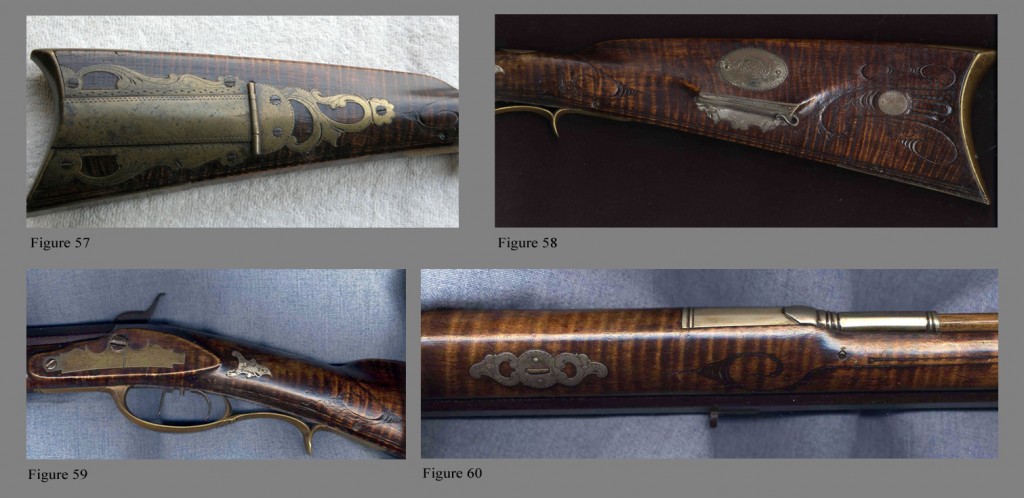
The following three longrifles continue the progression from the “Golden Age” well into the first quarter of the nineteenth century. The first is a diminutive, unsigned rifle (Fig. 56) by John (or possibly Jacob) Lauck working in his father’s gun shop in Winchester, VA. This well-appointed rifle is partially brass and partially silver mounted (ie. The patch box, butt plate, trigger guard, and side plate are brass; whereas, the nose cap, ramrod pipes, drawdown escutcheons, flash-hole pick holder, and decorative inlays are silver.) The well executed, daisy patch box (Fig. 57), decorated with punch work and minor engraving, is indicative of the Lauck shop. The double C-scroll on the butt stock (Fig. 58), containing both incised and low-relief carving and with the shock waves also is typical Lauck-shop work. Remember, these carving formulas were first introduced here on the John Haymaker rifle produced in the Lauck shop (see Figs. 16, 17, & 19). By the time this Lauck rifle was made, however, the carving had become more stylized, less academic in nature. Butt stocks had become thinner in cross-section. Fig. 59 shows other decorative features such as the side plate and the carving and silver inlay on the wrist. Both lock screws are present in the side plate further indicating the flintlock on this rifle was converted to percussion using the original lock plate, rather than being totally replaced with a percussion lock. Additional details shown in Fig. 60 include the drawdown escutcheon and rear ramrod pipe, both in silver. Also, note the shock-wave carving.
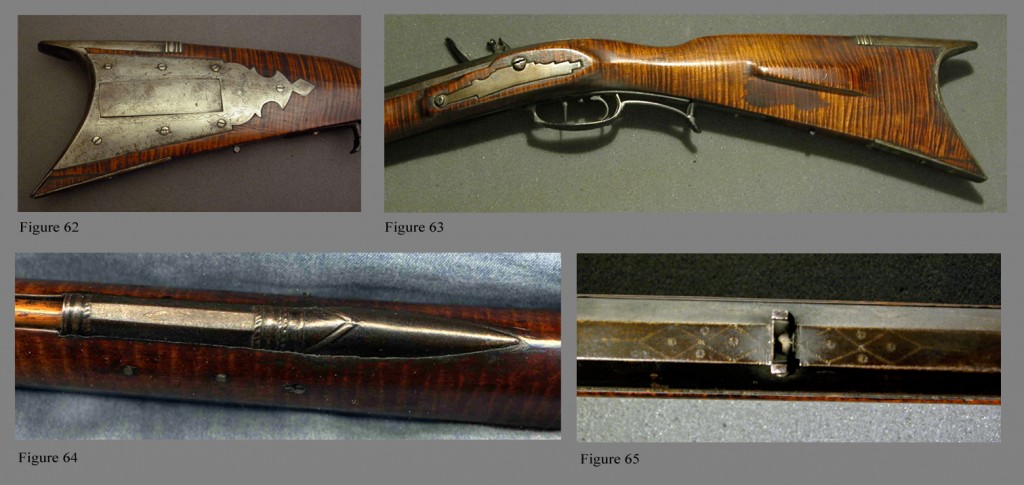
While most Kentucky rifles were multi-purpose tools, this second of three rifles (Fig. 61) was purpose built. It is a heavy match or target rifle with its original flintlock that was made in Wythe County, VA, a center for match shooting in the first part of the nineteenth century. While this rifle is iron mounted and does not have any carving, it was not a base-model rifle. Considerable care was taken in decorating its ironwork with engraving, punch work, moldings, and gadrooning or rope work (Figs. 62, 63, 64, & 65). The rifle is signed in script on its barrel (Fig. 66); however, the signature is illegible. The gunsmith was working in Wythe County in the 1820s. Does anyone have any ideas on the identification of this person?
The third longrifle under discussion in this group of three (Fig. 67) is unsigned. It was made in Covington, VA around 1825-30. This rifle exhibits more of a freeform or folk art approach to its decorative enhancements. The decorative elements do not really mesh with each other or integrate well overall with the rifle itself. Indeed, they just seem to be placed here and there on the rifle. The shells whimsically hanging on the sides of the engraved patch box (Fig. 67) are a case in point. Pawpaws are carved in full relief on the left side of the butt stock (Fig. 68). Pawpaws are far from conventional decorations on Kentucky rifles, if not actually unique here on this rifle. Nevertheless, they are well done and effective. The naive silver inlays, inlaid silver wire, pierced side plate, and pick holder all are enhancements. Note the engraved shell repeated on the pick holder. The checkering on the wrist of this rifle is the first encountered in this study. Checkering on a Kentucky rifle usually points to a later date. The brass cap on the toe of the butt stock is a period repair.
Thomas Cofer built the final rifle in this study in Portsmouth, VA mid-nineteenth century (Fig. 69). It is included here to illustrate the successor to and the end of the reign of the long, graceful Kentucky rifle. Cofer signed this small, percussion rifle on its barrel. By this period, the longrifle patch box had segued into a cap box for holding percussion caps (see Fig. 69), and the full stock became shortened to a half stock. During the transition from the traditional Kentucky rifle to this type of shorter rifle, many half-stock Kentucky rifles were produced. On the left side of the butt stock (Fig. 70), note the plethora of checkering, the washer-type side plate, the exaggerated curve of the butt plate, and the rather clumsy attempt at wire inlay using German silver.
A few makers continued to make longrifles well into the nineteenth century, and many, if not most, surviving, flintlock longrifles were converted to percussion. In back-country areas, numerous Kentucky rifles continued to see service through the Civil War and up into the early twentieth century. In fact, the Library of Virginia has in its collection an early twentieth-century photograph of a man somewhere in Virginia guarding his illegal whiskey still with a longrifle. Over the past 50 years, there has been a resurgence of interest in longrifles. In 1962, the Kentucky Rifle Association was born to promote the study, preservation, and collection of Kentucky rifles and to pass the tradition on to future generations. Interest in Kentucky rifles also has led to a substantial number of modern gunsmiths specializing in building contemporary or reproduction longrifles, many as beautiful as the originals. Brian LaMaster of High View, WV is but one of these highly skilled makers. In fact, he built the John Sheetz “Golden Age” copy in Fig. 1.
In summary, Kentucky rifles of all the periods, share this in common: they were graceful, aesthetically pleasing shooters regardless of their decorative enhancements. Through both words and photographs, we have attempted to answer the questions posed in the title of this article and to show that longrifles were functional utilitarian tools as well as works of art. The level of art depended upon the purchaser’s ability to pay. The modern, architectural terminology, “form follows function” certainly applies equally well to Kentucky rifles.
- Figure 1
- Fig 2
- Fig 3
- Fig 4
- Fig 5
- Fig 6
- Fig 7
- Fig 8
- Fig 9
- Fig 10
- Fig 11
- Fig 12
- Fig 13
- Fig 14
- Fig 15
- Figure 16
- Fig 17
- Fig 18
- Fig 19
- Fig 20
- Fig 21
- Fig 22
- Fig 23
- Fig 24
- Fig 25
- Fig 26
- Fig 27
- Fig 28
- Fig 29
- Fig 30
- Fig 31
- Fig 32
- Fig 33
- Fig 34
- Fig 35
- Figure 36
- Figure 37
- Fig 38
- Fig 39
- Fig 40
- Fig 41
- Fig 42
- Fig 43
- Fig 44
- Fig 45
- Figure 46
- Fig 47
- Fig 48
- Fig 49
- Figure 50
- Fig 51
- Fig 52
- Fig 53
- Figure 54
- Figure 55
- Figure 56
- Fig 57
- Fig 58
- Fig 59
- Fig 60
- Figure 61
- Fig 62
- Fig 63
- Fig 64
- Fig 65
- Fig 66
- Fig 67
- Fig 68
- Fig 69
- Fig 70
Published Feb 4, 2014 @ 16:39
Photo Credits:
Figs. 2, 3, & 4: Courtesy of Gordon Barlow and Giles Cromwell.
Figs. 11, 12, 13, 14, & 15: Courtesy of Jim Whisker. Because of size, complex construction with varied surface elevations, and assorted materials used in their construction, Kentucky rifles are notoriously difficult to photograph, especially outside of a studio. Prior to the widespread availability of digital cameras and smartphones, Dr. Whisker pioneered field photography of Kentucky rifles using a high-quality film camera, black and white film, long exposure times, and a moving light source to flood the rifle with light. These excellent images are representative examples of his work and are used here as a tribute to him. His numerous Kentucky rifle books, full of his photographs, continue to be a mainstay for longrifle scholars and collectors alike. Thanks Jim.
Fig. 36: Courtesy of Larry McArthur.
Published: Feb 4, 2014 @ 16:39
End Notes:
1. Shumway, Rifles of Colonial America, Vol. II, p. 510.
2. Ibid, p.510.
3. Ibid, pp. 511-513.
4. Wallace Gusler, personal communication. However, Bill Ivey in North Carolina Schools of Longrifles … p. 52 attributes this rifle to the Moore/Randolph County area of North Carolina.
5. Ibid, Ivey, p. 52.
6. Wallace Gusler, personal communication.
7. Ibid.
8. Gary Brumfield, personal communication.
9. See a full analysis and photographs of this rifle in Riflemaking Workmanship… by Wallace Gusler and Dave Harvey, pp. 1-52.
10. McArthur painting is in the Ohio Statehouse, Columbus, OH.
11. Larry McArthur, last family owner of one pistol, personal communication.
12. Remember, Frederick Sheetz trained in the Lauck shop; therefore, it is not surprising to see Lauck-shop features such as this shockwave, the opposing C-scrolls, etc. reappearing on his rifles as well as on the rifles of other gunsmiths who were trained in or influenced by the Lauck shop. We will see more examples later.
13. Doug Douglas, personal communication.
14. Wallace Gusler, personal communication.
15. Ibid.
Bibliography:
Butler, James T., Jr., and Whisker, James B., 1996, Long Rifles of Virginia: Bedford, PA, Old Bedford Village Press.
Gusler, Wallace and Harvey, David, 1993, Riflemaking Workmanship: A Rifle by John Sheetz: Friendship, IN, Journal of Historical Armsmaking Technology, Gary Brumfield, Editor, Vol. V, pp. 1-52.
Ivey, William W., 2010, North Carolina Schools of Longrifles 1765-1865: Thomasville, NC, published by author.
Lambert, Fred R. and Whisker, James B., 1997, Gunsmiths of West Virginia: Third ed., Bedford, PA, Old Bedford Village Press.
Shumway, George, 1980, Rifles of Colonial America, Vol. II: York, PA, George Shumway Publisher.
Whisker, James B., 1992, Gunsmiths of Virginia: Second ed., Bedford, PA, Old Bedford Village Press.
Whisker, James B., 2012, Gunsmiths & Allied Tradesmen of Virginia: Everett, PA, published by author.


